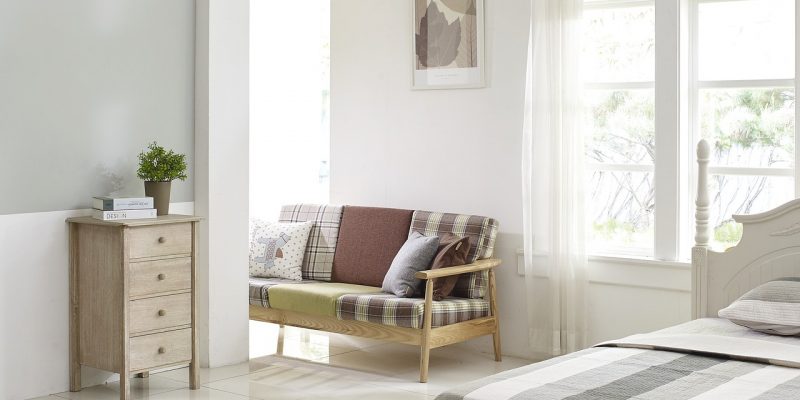Redesigning your bedroom can bring many benefits to your overall well-being. Studies show that simple changes like decluttering, introducing calming colors, and optimizing lighting can lower stress, boost mood, and even improve sleep quality. With Americans spending about a third of their lives in the bedroom, creating a space that you look forward to retiring to each night is important.
In fact, a survey by People magazine found that 78 percent of Americans say they would redecorate their bedrooms if doing so can increase the coziness of the space.
Redesigning your bedroom is a project that pays dividends far beyond aesthetics. Read on for some tips that will help you refresh your bedroom in ways that will make you excited to spend time in it.
Upgrade the bed
Since the bed is the bedroom’s focal point, invest in one that looks and feels indulgent. Before making a purchase, searching for the best bedroom furniture stores near you is a good idea to ensure you’re selecting top-quality options. Such stores often offer a range of styles and materials, helping you find the perfect match for your aesthetic.
Accompany your chosen bed with a high-quality mattress and pillows suited to your sleep style, whether you prefer plush, firm, or contouring support. Choose breathable natural fabrics like organic cotton or linen for your sheets, duvet cover, and blanket. Also, consider an upholstered padded headboard for extra comfort while lounging in bed.
To increase the coziness, add a plush area rug and soft throw blanket, where you can cozy up with a book. Making your bed each morning with beautiful linens instantly sets the tone for your bedroom as an orderly, welcoming space for sleep. An inviting bed makes even quick daytime rests feel special.
Declutter and organize
Clutter is the enemy of tranquility. It’s hard to relax in a room overflowing with stuff. Take time on a weekend to thoroughly review each area and be ruthless about getting rid of things you no longer need or use. Make three piles – donate, recycle/trash, and sell.
- Useful items like clothing in good condition can be donated to local charities, which benefits those in need.
- Outdated electronics, broken items, and unneeded papers should be recycled or trashed properly.
- Still-usable furnishings, accessories, or decor you’re ready to part with can be sold online for extra cash.
For what remains, invest in storage and organization systems to keep surfaces clear and maximize space. The less visual noise in your bedroom, the more its soothing elements will shine.
Introduce greenery
Adding plants to the bedroom is an easy way to make it feel more inviting. Greenery purifies the air while contributing natural beauty through vibrant colors and textures, bringing life and freshness to bedroom design.
Start by placing a few potted plants on your windowsill to take advantage of natural sunlight. You can also mount hanging planters on the wall above your bed for a splash of color.
If space allows, add a bench or chair by the window to create an impromptu reading nook surrounded by your new botanical buddies. You can curl up with a good book and enjoy the quiet tranquility of nature in your bedroom. Not only do plants look great, but spending time nurturing and appreciating them can reduce stress and improve your mood.
Use soothing color palettes
Color hugely impacts the vibe of a room. When redesigning your bedroom, stick to subdued hues known to evoke tranquility.
- Soft blues, sea foam greens, and pale grays create a relaxing, dreamy retreat.
- Creamy whites allow bolder accent colors to stand out.
- If you prefer a cozier effect, incorporate warm neutrals like beige, tan, light brown, and sand.
The paint color looks different on walls than on small sample chips, so purchase a sample pot to test on the wall before committing to the hue. Introduce new colors through pillow covers, art prints, area rugs, and bedding to jazz up the space.
Adjust the lighting
Lighting has a huge effect on a room’s ambiance. Make sure your bedroom has a variety of lighting options.
- For overall illumination, use soft white light bulbs in overhead fixtures.
- Warm lamplight is perfect for bedside reading nooks.
- If you have space in the room, add a floor lamp in a corner to create a nice glow.
- Dimmers allow you to control the exact brightness you need.
- You can also change your windows or invest in treatments tailored to your new room’s look.
Proper lighting sets the mood – a bedroom should transition from bright and energizing in the morning to a dim, peaceful haven at night.
Add personal touches
While designing for tranquility, don’t forget to infuse personality through meaningful personal touches. Make the room feel uniquely you by displaying special items that bring joy. For many, that means showcasing travel mementos like maps, postcards, or photos from adventures abroad. Here are some more tips:
- Frame and arrange favorite art prints or inspirational quotes to decorate the walls.
- Photos of family, friends, or pets add endearing accents while honoring important relationships.
- Choose bedding, rugs, curtains, and other linens in colors you like to add pops of color that reflect your spirit.
- Arrange books you love on the nightstand for easy access before bedtime reading.
- Add shelves or floating ledges to showcase collections, hobbies, or other passions. For example, a shelf of succulent plants or a display of vintage cameras.
A bedroom should reflect who you are on the inside, so surrounding yourself with personal touches that make you smile creates a welcoming retreat.
Conclusion
By decluttering, adding greenery, using tranquil colors, upgrading your sleep space, and making the room your own, you can create a bedroom that reduces stress and improves your quality of life. A well-designed bedroom that you look forward to retiring to each evening can enhance your mental and physical health. With just a little effort, your bedroom can become your sanctuary.




















